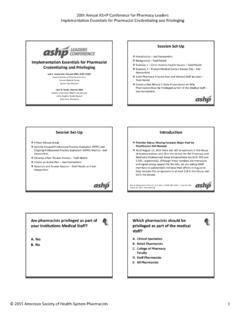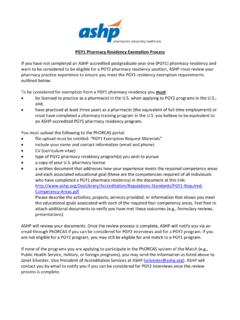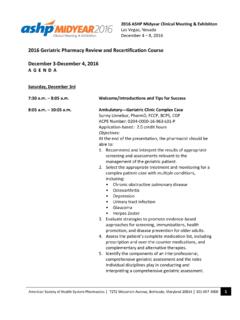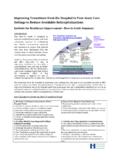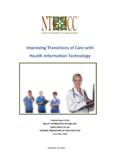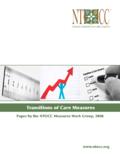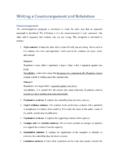Transcription of Implementation of a Novel Resident-led Pharmacy ...
1 Implementation of a Novel Resident-led Pharmacy Transitions of care Service Submitted by: Kate Perica, , BCPS, Medication Reconciliation Coordinator, 720-848-8593, and Lisa Slater, , Transitions of care Clinical Pharmacist, 720-848-3152, University of Colorado Hospital UCHealth, 12605 E. 16th Avenue, Aurora, CO. pharmacists, Pharmacy and community Pharmacy residents, and student pharmacist interns to create opportunity for professional growth while providing enhanced care to our patients. 5. Improve PGY1 resident satisfaction by requiring staffing through inpatient Pharmacy clinical services and the Pharmacy transitions of care service, thus providing diverse experiences and decreasing the frequency of weekend staffing. Relevant PAI Recommendations B7. Hospital and health-system pharmacists must be responsible and accountable for patients' medication- related outcomes. B20. Pharmacists should facilitate medication-related Lisa Slater, and Kate Perica, , BCPS.
2 Continuity of care . B23: The following characteristics or activities should be Primary Intended Outcomes considered essential to pharmacist-provided drug- 1. Manage patients through their transition from the therapy management in optimal Pharmacy practice acute care setting back into the community after models: discharge by focusing on medication- and B23a. Accountability for the development and Pharmacy -related needs. documentation of medication-related components of 2. Ensure admission medication history is obtained the patient care plan. and medications are reconciled with acute care B23k. Medication reconciliation in the emergency orders, provide education regarding medications department; upon admission, interhospital transfer, and disease states, coordinate discharge needs to and discharge; and in the ambulatory care setting. help decrease potential medication errors, adverse B23l. Establishment of processes to ensure events, or readmissions. medication-related continuity of care for discharged 3.
3 Establish interprofessional involvement patients. focusing on care progression planning that B23m. Provision of discharge education to patients. includes Pharmacy in order to build relationships with providers, nurses, case managers, social workers, physical/occupational therapists, and patient liaisons. 4. Provide a layered learning model with clinical Situation Analysis Service Description University of Colorado Hospital (UCH) is a 648-bed Clinical pharmacists participate in rapid interprofessional academic medical center within the UCHealth system. discharge rounds each morning with internal medicine UCH is regionally ranked as the #1 hospital in Colorado teams, apply inclusion/exclusion criteria to identify patients and is nationally ranked in 10 adult specialties. who could benefit from PTOCS involvement, provide Pharmacy practice development is strongly facilitation of service-related information, and maintain supported to enhance medication safety and patient data collection.
4 A sign-out report within the electronic satisfaction. Interprofessional team efforts with health record (EHR) is updated to communicate patient Pharmacy presence are utilized for the best outcomes needs and movement. Group messages within the EHR are possible. used to communicate the checklist of patient needs to the evening staff. A secure online portal for training tools and Since mid-2015, PGY1 Pharmacy residents have been references is utilized by the PTOCS group to have creatively involved with staffing a new Pharmacy resources and supportive documents readily available. This Transitions of care Service (PTOCS) to focus on is also where data collection is stored for assessment of managing patients and their medication-related our service and identification of trends. Frequent workflow needs through transition from the acute care setting enhancements are implemented based on feedback from back into the community. The PTOCS qualifies as a the residents and interns.
5 Portion of each resident 's staffing requirement and allows less frequent weekend staffing as a result. This Residents and interns staff the PTOCS Monday through unique idea resulted from the acknowledgement of a Friday from 4:00 pm to 8:00 pm. These specific hours of previously unmet need to focus on fragile points of operation were selected to keep residency program transitions of care and methods to potentially rotations a priority. Rotations usually run from 7:00 am to decrease the rate of readmissions to the hospital. The 3:30 pm. This schedule allows residents to staff PTOCS. timing coincided with a desire to create new staffing after their rotation. Typical staffing includes one resident opportunities for residents and also to support a and one intern working together each evening. They partnership with the University of Colorado Skaggs introduce the service to patients for voluntary enrollment School of Pharmacy and Pharmaceutical Sciences and are responsible for ensuring completion of admission (SSPPS) as they added a new rotation component to medication history, verification of prescription insurance their Community Pharmacy residency program.
6 Coverage, and counseling of disease states and anticipated discharge medications during hospitalization. They identify The PTOCS has evolved to now include two UCH and communicate potential Pharmacy -related barriers to clinical pharmacists, six Pharmacy PGY-1 residents, the primary internal medicine team, coordinate three Community Pharmacy PGY-1 residents, and prescription processing with the hospital discharge eight Pharmacy interns. In approximately 18 months Pharmacy , fax final discharge medication lists to the since service Implementation , over 800 patients have patient's preferred established community Pharmacy , and been enrolled in the PTOCS to receive bedside conduct a post-discharge follow up phone call to answer medication education, coordination of discharge questions, encourage adherence, and offer triage to needs, and post-discharge telephonic outreach. The reduce likelihood of readmission. Patients fall within residents gain invaluable patient experience in this different checklist categories based on whether they are role and are also given the opportunity to practice still hospitalized or already discharged.
7 Preceptorship by being paired with an intern learner on each shift. All members of the PTOCS group are expected to address discrepancies and potential medication-related barriers as part of the care progression planning prior to IT and other infrastructure: electronic health record (Epic . discharge. Pharmacists will address urgent issues as ), software for data collection and reference sharing needed, but complete coverage of the PTOCS is not (Microsoft Excel, Microsoft SharePoint), hospital available outside of the normal operating hours. intranet for access to online drug information tools, Partnerships with the patient's primary internal dedicated phone line with voicemail, fax machine, and two medicine team allow for follow through with computer workstations. recommendations and interventions. Thorough documentation in the EHR is made available for Supply Expense: None. A shared office space with review by others by updating medication histories, departmental computers and supplies is utilized.
8 Detailing education activities, and outlining all steps of the PTOCS process in a detailed progress note. Return on Investment: Positive patient and provider feedback from anecdotal responses within post discharge Key Elements for Position Success follow up calls and involvement in interprofessional care 1. Establish a service model to involve pharmacists, progression teams. Increased prescription capture within residents, and interns in transitions of care . hospital discharge Pharmacy . Workplace satisfaction 2. Practice within an interprofessional approach to improvements for the clinical pharmacists, PGY1 residents, focus on care progression planning and needs to interns, and members of interprofessional teams. identify and troubleshoot potential barriers Collective focus to decrease length of hospital stay, though proactively. formal assessment of length of stay related to the PTOCS. intervention has not been conducted. 3. Timely identification of anticipated discharges to allow for adequate Pharmacy involvement before discharge.
9 Recognized Intangible Benefits 4. Support from hospital and school of Pharmacy The addition of this service has extended the ability for leadership to adjust residency requirements to re- pharmacists, residents, and interns to reach out to high risk distribute resident staffing time to the PTOCS. patients. These patients receive focused education and 5. Establish PTOCS as a longitudinal staffing coordination to proactively work through medication- requirement, thus enabling personal and related barriers and follow up after discharge from the professional growth in the Pharmacy residents hospital to ensure success. Also, community pharmacies and interns over the course of the year. are now receiving communication about changes to the patient's medication list, allowing for information sharing and partnership with the hospital for the patient's Resource Utilization transition of care . All members of the PTOCS are shared Personnel: Two clinical pharmacists, nine PGY1 within the Pharmacy department or school of Pharmacy residents, eight Pharmacy interns.
10 All PTOCS and have other job duties and expectations, therefore participants are shared members of the UCH there was no need to acquire additional full-time Pharmacy Department or University of Colorado equivalents (FTEs) with the development and SSPPS and also fulfill other roles and duties. Implementation of this program. Outcome Measures Lessons Learned 1. Phone call interventions (over the most recent 9 1. The longitudinal and layered learning approach month period), as assessed by resident or intern provides a unique opportunity for residents and conducting call: interns to develop skills that can be applied in any future area of practice. a. 36%: no questions or concerns from 2. Points of transition in healthcare are unpredictable and patient many outlying situations can change the course for a b. 25%: patient had a logistical question patient to successfully discharge from the hospital. Scenarios identified through care progression c. 32%: resident /intern used clinical skills planning, discharge, and movement back into the to answer patient questions community necessitate Pharmacy personnel to often d.

